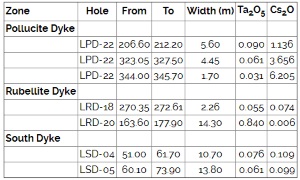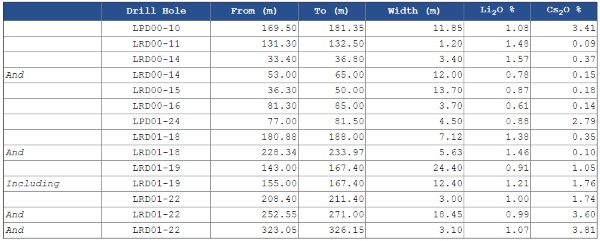Avalon Advanced Materials Inc.
Lilypad
Location, ownership and access

Avalon’s Lilypad Cesium Property consists of 14 claims totaling 3,108 ha covering a field of cesium, lithium and tantalum-rich granitic pegmatites. The claims were staked by Avalon between January 1999 and October 2000 and are 100% owned by the company. The property is located 150 km northeast of Pickle Lake, Ontario near the First Nation community of Fort Hope of the Eabametoong First Nation. It is presently only accessible by air or winter road.
An initial reconnaissance mapping and sampling program carried out by Avalon in 1999 confirmed the presence of economically-significant cesium-lithium-tantalum mineralization at several locations on the property.
Advanced materials
Cesium is a widely used advanced material with uses in specialty drilling fluids; atomic clocks; electric power devices that convert heat to energy; photoelectric cells for medical devices and videography; and in ion engines designed for space crafts on extended missions. Cesium is also used to make special optical glass, as a catalyst promoter, in vacuum tubes and in radiation monitoring equipment.
Cesium’s importance in the atomic clock should not be overlooked – its qualities allow cell phones, GPS and the internet to align with extremely accurate timing. A cesium atom is so constant in the speed it vibrates that a cesium-based clock takes millions of years to lose just one second. This extremely-accurate time allows satellites to determine where someone is based on GPS data.
More than two-thirds of the world's reserves of cesium are found in Canada, with reserves also found in Zimbabwe, China, Namibia and, recently, Australia. However, most commercial production is as a by-product of lithium and/or tantalum projects.
Tantalum has the best known ability of all metals to store electricity. It is very rare, averaging just 2 ppm in the earth’s crust. The majority of tantalum produced is used in the manufacture of electronic capacitors, which are fundamental to all electronic products. Tantalum’s ability to store electricity in small capacitors has allowed the miniaturization of aviation electronics, miniaturization of computers to desktop and laptops, and the miniaturization of all hand held electronic devices such as cell phones and radios. Furthermore, tantalum’s inertness or immunity to attack by chemicals and its non-allergenic character lend to its use in surgical appliances and prosthetic implants.
Current tantalum producers are found in Rwanda, the DRC, Nigeria, Australia, China and Ethiopia. Tantalum is often found as the mineral tantalite along with the tin mineral cassiterite - both as heavy minerals that accumulate in secondary (placer) deposits. Such sources in Central Africa often see production by guerrilla groups through child labour, leading to its designation as a conflict mineral.
Lithium is well known for its growing use in battery technology, as well as high strength glass and ceramics. Avalon’s advanced Separation Rapids Lithium Project is also a potential producer of lithium minerals.
Geology
Rare metal pegmatites on the Lilypad property occur over a minimum area of 10 km2. Diamond drilling conducted by Avalon in 2001-2003 focused mainly on the tantalum potential.
All of the known pegmatites tested by drilling exhibit good continuity to depth, high degrees of fractionation and are enriched in cesium, lithium and tantalum, as well as rubidium. Cesium occurs in the mineral pollucite and lithium occurs primarily in both spodumene and lepidolite in the dykes explored to date.
Drill intercepts from a 2000-2001 drill campaign with cesium and lithium values are listed in the tables below. Cesium values in the Pollucite Dyke range up to 6.2% Cs2O over 1.70m and is so named because the cesium ore mineral pollucite is one of the dominant mineral phases in this dyke.
Nine drill holes encountered lithium above the 0.6% cutoff for the intercept, with some holes with multiple intercepts. For example, drill hole LRD01-22 had three separate intercepts including 1.0% Li2O over 3m, 1.0% Li2O over 18.45m and 1.07% Li2O over 3.7m - all of which were accompanied by cesium values at greater than 1% Cs2O.
Selected Significant Tantalum and Cesium Intercepts

SD drill holes completed by Tanco
Lithium Intercepts at Lilypad Lakes Property, with a reporting cutoff of 0.6% Li2O

Project timeline and future plans
Encouraging for the future development of the Lilypad Cesium property is the fact that significant mineral discoveries to the north (Ring of Fire) have prompted discussions involving the Ontario government about developing road access into the area. This would greatly enhance the economic viability of any mineral deposits present in the region, including the cesium-lithium-tantalum deposits in the Lilypad area.
Economic resources of the cesium ore mineral pollucite are very rare and Lilypad represents one of the very few known significant occurrences of this rare mineral in the world. With declining production from traditional sources, new producers are needed for this scarce advanced material to meet growing demand.
As a result, Avalon is planning to re-activate the project with an exploration program that will be focused on cesium. This program will include geological mapping and sampling, as well as geochemical surveys.
The Lilypad property is located in the traditional territory of the Eabametoong First Nation. The company has initiated consultation with the community at this early stage of exploration, in anticipation of making economic discoveries of cesium mineralization. Avalon is committed to negotiating mutually beneficial partnership agreements with its First Nation neighbours.
Source: http://avalonadvancedmaterials.com/projects/lilypad/

|